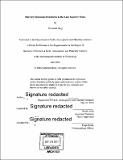Mercury emissions inventories in the Lake Superior states
Author(s)
Berg, Elizabeth (Elizabeth J.)
DownloadFull printable version (5.581Mb)
Other Contributors
Massachusetts Institute of Technology. Department of Earth, Atmospheric, and Planetary Sciences.
Advisor
Noelle Selin.
Terms of use
Metadata
Show full item recordAbstract
Mercury pollution can cause harmful impacts on human health and the environment, a concern that is magnified in marine environments like the Great Lakes. While there are many local, national, and global efforts to track emissions, one key complication to accurately estimating atmospheric mercury is the disagreement between the two national EPA inventories, the National Emissions Inventory (NEI) and Toxics Release Inventory (TRI), which differ in both location and magnitude of emissions. By comparing the NEI and TRI datasets from 2008 and 2011 in the states bordering Lake Superior, this study aims to uncover potential biases in each inventory and determine when a given inventory is more accurate. Additionally, year-to-year TRI emission totals since 2000 are studied to produce a more precise visualization of mercury trends in the Lake Superior Basin. The most notable difference between the two inventories was the absence of mining in TRI, one of the most significant sectors in NEI for both years studied. The utilities sector, however, showed more agreement between the two inventories. The relationship between the NEI and TRI numbers for the facilities within the utilities sector that were found in both datasets was found to be TRI = (1.206)NEI, matching the results from a previous study. Additionally, the study of the yearly TRI data from 2000 to 2014 showed that while average emissions per facility have been declining since 2000, particularly in the manufacturing sector, there is a surprising degree of variability in yearly totals than expected, exposing a potential topic of future research.
Description
Thesis: S.B., Massachusetts Institute of Technology, Department of Earth, Atmospheric, and Planetary Sciences, 2016. Cataloged from PDF version of thesis. Includes bibliographical references (pages 41-43).
Date issued
2016Department
Massachusetts Institute of Technology. Department of Earth, Atmospheric, and Planetary SciencesPublisher
Massachusetts Institute of Technology
Keywords
Earth, Atmospheric, and Planetary Sciences.